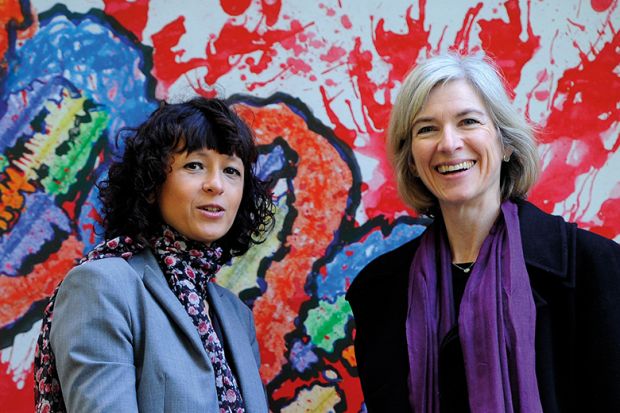With Emmanuelle Charpentier and Jennifer Doudna making history by becoming the first women to share the Nobel Prize in Chemistry, this year’s line-up of laureates was noticeably more diverse than in previous years.
The unusually high number of female winners – Andrea Ghez shared the physics prize – arguably overshadowed a different kind of diversity in this year’s science laureates: only one of the eight studied at undergraduate level at Oxbridge, the Ivy League or one of California’s most outstanding research universities, the big beasts of global higher education that have dominated science’s top prize in modern times.
Instead, three of this year’s laureates took their undergraduate degree at relatively modern institutions: Professor Charpentier studied at Pierre and Marie Curie University, which opened in 1971 after the dissolution of the University of Paris, while medicine laureates Charles Rice and Michael Houghton went to the University of California, Davis (which gained university status in 1959) and the University of East Anglia (opened in 1963), respectively.
With the Nobel prize usually awarded, in recent times, to scientists in their mid- to late sixties, this year’s crop of winners raises the tantalising prospect that the educational background of future Nobel winners may be radically different – and more diverse – from past ones.
Moreover, some wonder whether the more experimental teaching and research practices found at these newer universities – particularly in their early days – may actually be a key factor in some of the Nobel-worthy scholarship now being honoured.
“An established university can be very innovative, but there is an interesting question of whether new ways of doing research can be encouraged by the creation of new institutions,” said Lord Willetts, the former UK science minister whose own desire for new universities while in office drew, in part, from his admiration for the “plate-glass” universities established in the UK in the 1960s as part of the massification of higher education recommended by the Robbins report.
As the Nobels “tend to pick up on research done 20 or 30 years ago by researchers when they were younger”, it was not unexpected that the work of students and young researchers from the universities of Sussex, Warwick and York and other 1960s institutions such as UEA was now starting to be recognised internationally, he said.
The sense of younger scientists taking the lead on research and teaching was a defining feature of UEA in the early 1970s, said Michael Balls, who taught biology there from 1966 to 1975 and was named last week by Professor Houghton as an example of one of the “great lecturers” he encountered in Norwich.
“There were about 30 new lecturers aged 30 or under, plus half a dozen established professors. Given the very democratic system which had been set up, we regularly outvoted them, especially when they tried to make us do things in a traditional way,” explained Professor Balls, now emeritus professor of medical cell biology at the University of Nottingham.
“We were highly stimulated by the novelty of what we were doing and our freedom to do it, and this was transmitted to our students.”
Professor Balls noted that Sir Paul Nurse, a future medicine Nobelist, was a PhD student at UEA in the early 1970s, while his own first PhD student, Dennis Brown, also a UEA undergraduate, is now a professor of medicine at Harvard University and was until recently president of the American Physiological Society.
“I have always looked forward to being outsmarted by my students – they were younger, technically more gifted and braver, so I’ve been delighted to watch them prosper,” Professor Balls said.
Two of this year’s laureates also earned undergraduate degrees at small universities or liberal arts colleges, albeit historically prestigious ones: Professor Doudna went to Pomona College, in California, and medicine winner Harvey Alter to the University of Rochester in New York.
Professor Doudna’s liberal arts background was relevant as studies have shown that these institutions have a better record of encouraging women to take science PhDs than elite research universities, said David Pendlebury, senior citation analyst at Clarivate, who has studied the undergraduate background of US scientists.
“Selectivity is clearly one important element in the success of the elite liberal arts colleges in producing scientists, but I suspect that even more important, however, is the greater likelihood that a close student-teacher relationship will develop in the setting of a small class than in a large lecture hall, such as is typically encountered at large universities,” said Dr Pendlebury.
“Undergraduates at such institutions often had the opportunity to do real research with their professors, whereas at some elite research-intensive institutions, the hands-on work was traditionally done by graduate students and postdocs.”
The historic success of Professors Doudna and Charpentier is important on many different levels, observed Muzlifah Haniffa, professor of dermatology and immunology at Newcastle University, who noted that the duo represented one of very few Nobel wins for women not also shared by a man – or indeed a husband.
“Their victory is important from the perspective of female role models, but they show how the talented individuals who win Nobel prizes increasingly go to a diverse range of universities,” said Professor Haniffa.
jack.grove@timeshighereducation.com
Science’s new generation? 2020 Nobel prizewinners
Chemistry
Emmanuelle Charpentier, director, Max Planck Unit for the Science of Pathogens; Jennifer Doudna, professor of biochemistry, biophysics and structural biology, University of California, Berkeley, “for the development of a method for genome editing”.
Physics
Sir Roger Penrose, emeritus Rouse Ball professor of mathematics, University of Oxford, “for the discovery that black hole formation is a robust prediction of the general theory of relativity”.
Reinhard Genzel, director, Max Planck Institute for Extraterrestrial Physics; Andrea Ghez, Lauren B. Leichtman and Arthur E. Levine professor of astrophysics, University of California, Los Angeles, “for the discovery of a supermassive compact object at the centre of our galaxy”.
Physiology or medicine
Harvey Alter, senior scholar, department of transfusion medicine, National Institutes of Health Clinical Center; Michael Houghton, Li Ka Shing professor of virology, University of Alberta; Charles Rice, professor of virology, Rockefeller University, “for the discovery of Hepatitis C virus”.
POSTSCRIPT:
Print headline: Nobel lineage may be in for an infusion of new blood
Register to continue
Why register?
- Registration is free and only takes a moment
- Once registered, you can read 3 articles a month
- Sign up for our newsletter
Subscribe
Or subscribe for unlimited access to:
- Unlimited access to news, views, insights & reviews
- Digital editions
- Digital access to THE’s university and college rankings analysis
Already registered or a current subscriber? Login









